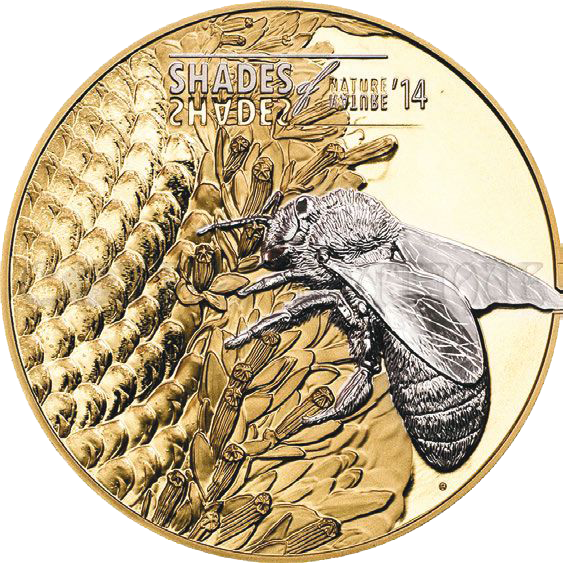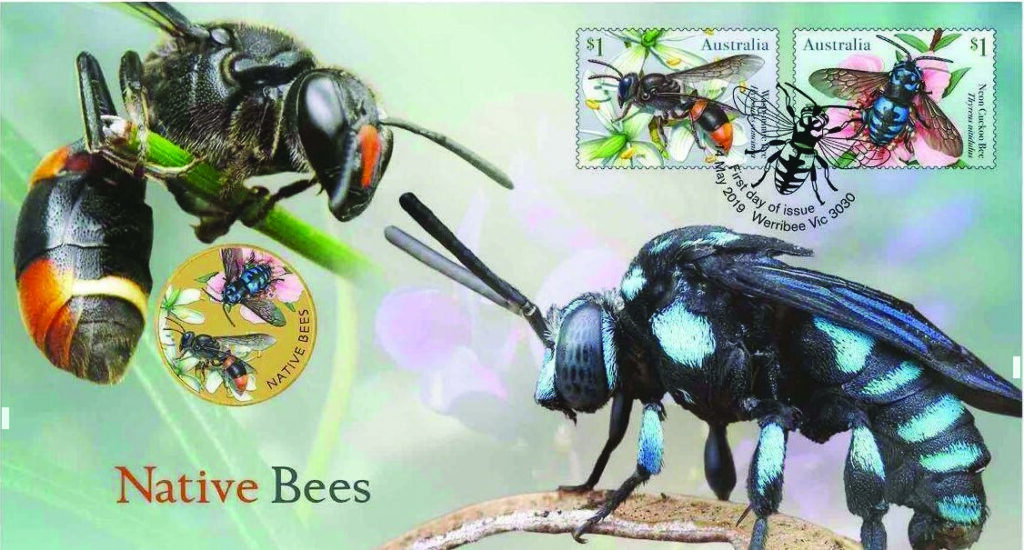
Adrian G. Dyer, PhD, authored a remarkable article delving into the historical interplay between honey and money. Let’s dive into the article.

Figure 1. New Zealand 2016 silver hexagonal one dollar collectors coin featuring the honeybee (Apis mellifera) and incorporating innovative resin inclusions to represent golden honey. Image courtesy of New Zealand Post.

Figure 2 The 2014 Shades of Nature coin from the Cook Islands gilded silver coin employs very high standards of production for the collector market. Image courtesy of CIT.

Figure 3. Australian Native Bee 2019 PNC from Perth Mint with coloured one dollar coin from Tuvalu. Image courtesy of Australia Post.
In recent times, there have been a number of impressive coins showing representations of bees, like the 2016 New Zealand hexagon shaped dollar coin designed for collectors (Fig. 1), and its sister hexagon coin in 2018 featuring manuka honey. Similarly, the Cook Island Shades of Nature gold-plated silver coin (Fig. 2) and the Australian Native Bees PNC (Fig. 3) both pay homage to the bee. This interest is likely linked to factors like the importance of bees to producing food, increasing public awareness about the plight of bees as an important key species in the environment, as well as improved modern manufacture processes of mints to enable producing innovative and often colourful designs. Indeed, around the world a number of mints are producing coins for both collectors as well as circulating coins featuring bees as the main design subject. In a recent open research article1, we investigated if the contemporary interest in representing bees is a modern phenomenon linked to major media reporting about bees, or if there are deeper roots to human culture and art practice. The Greek island of Aegina is thought to have been one of the first places in Europe to issue coins like the turtle silver stater from around 510BCE-485BCE shown in Figure 4. Figure 5 shows that in ancient Greece bees, were also already featured on coins before 400BCE, suggesting the importance of these animals to the communities developing the skill to mint some of the world’s first coins. Prior to the invention of coins, bees as a motif was additionally a feature of cave art, music and song lines in many countries like Spain in Europe and in Australia, suggesting that bee art representations, including on coins, were a culturally and artistically diverse subject to represent1. Indeed, honey has been a highly prized trading commodity since the time of the Egyptian pharaohs with well- preserved honey being found in the tomb of Tutankhamun, and honey was likely a portable commodity enabling efficient trading in many parts of the world before the advent of coins.

Figure 4. Silver Stater from around 510BCE-485BCE from the Greek island of Aegina showing a turtle on the obverse and an incuse square quartered on the reverse. Author provided CC 4.0

Figure 5. A silver Greek obol coin minted in Macedon 412BCE-350BCE showing a bee on the obverse and an incuse square quartered on the reverse. Housed at the British Museum. CC BY-NC-SA 4.0.

Figure 6 A bronze coin of 2.35g minted in Ephesus (modern Turkey) around 387BCE-295BCE showing a bee on the obverse and a kneeling stag on the reverse together with a Greek inscription. Housed at the British Museum. CC BY-NC-SA 4.0
At a similar time, bees start being featured on coins minted in other nearby communities, like the bronze coin minted in the city of Ephesus in Ionia (on the Aegean coast of modern Turkey) from around 387BCE-295BCE (Figure 6) and the bronze coin (Figure 7) from Ephesus 202BCE-133BCE. Thus, bees as a main design feature persisted on ancient coins over several centuries with many hundreds of varieties known to exist, and new varieties continue to be discovered in contemporary times2. A frequent question in design is; why do we like, what we like? The field of neuro-aesthetics seeks to address this question by considering what are the basic principles that might underpin aesthetic appreciation, and it is likely in the case of honey and money that both the sweet tasting of valuable honey, and a cross cultural appreciation of the benefits of bees to how we live and work, is why bees were and continue chosen to be represented on coins1.

Figure 7. Bronze coin of 1.4g minted in Ephesus (modern Turkey) around 202BCE-133BCE featuring a honeybee. Author provided CC 4.0.

Figure 8. A 1920R circulating 10 centesimi bronze coin from Italy (KM#60, 5.34g) with the Italian honey bee (Apis mellifera ligustica) on the reverse side. Image courtesy of PCGS.

Figure 9. A 1953R circulating 2 Lire aluminium coin from Italy (KM#94; 0.8g) featuring on the obverse side the Italian honey bee (Apis mellifera ligustica). Image courtesy of PCGS.
This attraction shows evidence of persisting from ancient time to modern times before the widespread mass media. The Italian 10 cent (Figure 8) features an Italian honeybee (Apis mellifera ligustica) visiting a flower in a series that ran from 1919R to 1937R (the 1919R date is rare). The popularity of featuring honeybees on circulating coins in Italy continued for most of the 20th Century with the aluminium 2 Lire coin released in 1953 with a design that was continued up to 1981 as circulating coins, and 2001 in collector sets before the Euro currency was introduced. Interestingly, in Australia, Kangaroo Island now contains the last stock of pure Italian honey bees due to an act of parliament in 1885 that declared the island a sanctuary for Ligurian bees; whilst globalisation has resulted in interbreeding of honeybees elsewhere. Many other countries have used bees as features of design on both circulating and collector coins. Figure 10 shows a circulating 1972 aluminium 3 mils coin from Malta with a honeybee represented against the honeycomb within a hive. Proof coin sets from Malta for this series include an information card stating “A bee and honeycomb are shown on the 3 mils coin, symbolising the fact that honey was used as currency in Ancient Malta”. The link between honey and money has indeed been persistent over several millennia. One of the most interesting series of modern coins was issued by the United Nations Food and Agriculture Organisation (FAO),

Figure 10. A circulating 1972 aluminium 3 mils coin from Malta (KM#6) with an obverse design of a honeybee and honeycomb. Image courtesy of PCGS.

Figure 11. A circulating copper-nickel 20 Senti coin from the Tonga (KM# 46, 11.3g) shows a reverse side that celebrates the contribution of bees to food production as part of the United Nations Food and Agriculture Organisation (FAO) international coin program. Image courtesy of PCGS.

Figure 12. The RAM 2022 two dollar coin representing 200 years since the honeybee was introduced to Australia in 1822 aboard the merchant ship Isabella that was also transporting convicts and provisions. Image courtesy of the Royal Australian Mint.
promoting sustainable agricultural and cultural development in many countries 3, and frequently animals important to agriculture. For example, the Tonga 20 senti FAO coin (Fig 11) shows 20 honeybees flying out of a modern hive. Interestingly, the FAO has promoted research and reported on the threat posed to bees and thus agricultural production due to factors like climate change, with estimates of the contribution of bee pollination to world food production of about 1/3rd of the food required to feed the world, worth in excess of US$200 Billion/year4,5. Public awareness of these pollinator-related issues are a likely factor in the current interest in bee coins, but the diversity of countries using bees as a design feature over the entire life of coins suggests human communities have long valued our relationship with bees as essential to our own prosperity. In Australia, the impressive two dollar Royal Australian Mint coloured coin series recently added a honey coloured “The Sweetest Coin You Will Collect” carded coin acknowledging the 200 years since the honeybee was introduced to Australia (Fig.12), and indeed the honeybee has been of high economic value to many agricultural sectors especially for the production of fruits and nuts. However, Australia has many native bees that also require acknowledgement for their contribution to the health and wellbeing of our society 5, like that represented on some PNC products (Fig. 3), and the broad contribution of essential pollinators is likely to continue to be an important motif for coin design for many years to come.

Another exciting reward for our army of ACR subscribers is ...

July 2024 marks the 60th anniversary of the first issue ...

Another exciting reward for our army of ACR subscribers is ...